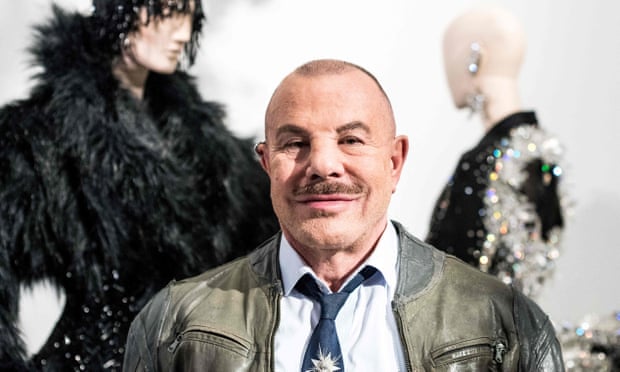Thierry Mugler, genre-busting French fashion designer, dies at 73
By Jacob Bernstein
PARIS – Thierry Mugler, the outrageous, genre-busting French designer who dominated European runways in the late 1980s and early 1990s, died Sunday (23). He was 73.
His death was announced on his brand’s official Instagram. “#RIP,” it said. “We are devastated to announce the passing of Mr. Manfred Thierry Mugler on Sunday Jan. 23, 2022. May his soul Rest In Peace.”
Reached Sunday evening, two of his close friends confirmed his death. No cause was given.
Mugler, born in Strasbourg, France, was one of the principal architects of a late eighties aesthetic that married S&M and high fashion. His silhouette was a kind of inverse triangle with giant shoulders and a nipped waist. He loved latex, leather and curves.
His early muses included Grace Jones and Joey Arias. He had a long-standing creative collaboration with David Bowie, and even dressed him for his wedding to Iman. And George Michael’s ‘Too Funky’ was effectively a televised Mugler show.
In the video, Linda Evangelista was done up like a space age Cruella De Vil, wearing a peroxide blond wig and dripping in fur. Another model strode out in a metal Harley-Davidson inspired bustier with actual motorcycle handles sticking out of each side of the waist, rear view mirrors attached to the breasts, and a headlight in the centre.
But Mugler’s unabashed embrace of gay iconography overshadowed his spectacular tailoring and construction technique, ghettoizing him at a time when the AIDS epidemic had become a political battleground.
“The outwardness of designers embracing being gay wasn’t then a thing,” said Paul Cavaco, who during Mugler’s heyday was the fashion director of Harper’s Bazaar. “People knew but you didn’t really talk about it. It was considered not chic. And here he was sending drag queens like Lypsinka down the runway.”
So even at Bazaar, which at the time was arguably the most adventurous American fashion magazine, Mugler’s clothes were largely passed over, Cavaco said.
In 1997, Mugler’s brand was purchased by Clarins, the beauty conglomerate.
Whether Mugler happily left his brand in 2002 or jumped out of the industry to avoid being pushed, he continued to work. In 2003, he served as the creator of Zumanity, a Cirque du Soleil show in Las Vegas that featured his good friend Arias, much lace, and many corsets. It ran until March 2020, when the advent of COVID-19 caused theatres around the world to shut down. Mugler’s perfume Angel remained wildly successful. A new generation of pop stars and designers mined him for inspiration.
Alexander McQueen’s punk posh sensibility owed much credit to Mugler’s work. As did Lady Gaga’s early ‘Bad Romance’ look. Beyoncé wore the old motorcycle bustier on the cover of her 2009 album ‘I Am … Sasha Fierce’.
Around that time, Mugler’s own extreme physical transformation into a comic book, leather-gear wearing, supervillain, became tabloid fodder. Nude photos of him with pecs wide as a city block leaked across the internet. He changed his first name from Thierry to Manfred.
Then, as red carpets became glorified reality shows in which celebrities competed to outdo each other in the category of campy theatricality, Mugler made a comeback.
Cardi B showed up to the Grammys like a Disney princess in a flesh-toned bodice, with sequins across her chest and a blooming skirt that shot up from behind her — a human pearl, nestled in her pink shell. A few months later, Kim Kardashian made her entrance at the Met Gala in a Mugler designed dress that made her every curve appear to have been drenched in high fructose corn syrup (or something else). Those viral looks introduced him to millions of new fans. The current creative director for Mugler, Casey Cadwallader said that Mugler, “changed our perception of beauty, of confidence, of representation, and self-empowerment.”
-New York Times
es


